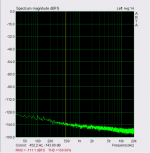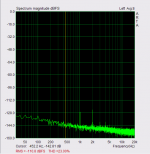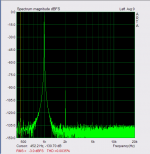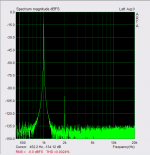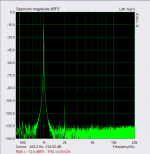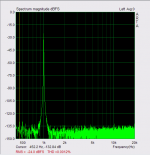I like this one. For this application I think you should better try a low Hfe one (rather C then F-grade) the gain of the BC is high enough.
That doesn't look too slow. However, be sure to choose a transistor with good quasi-sat behavior. I found that the 2SC5171/A1930 and C4793/A1837 gave the best behavior out of the ones I was able to try.
A B-C cap on the driver is one of the least effective ways to compensate a CFP. It will dramatically worsen PSRR and may just make it more unstable. Instead you may try a 470p-4.7n cap across the B-E of the pass transistor. However some combinations of current/bias are pretty difficult to stabilize.
But I think the oscillation will be solved quite amiably by an input lytic.
A B-C cap on the driver is one of the least effective ways to compensate a CFP. It will dramatically worsen PSRR and may just make it more unstable. Instead you may try a 470p-4.7n cap across the B-E of the pass transistor. However some combinations of current/bias are pretty difficult to stabilize.
But I think the oscillation will be solved quite amiably by an input lytic.
I just checked the Cob of the BC161-16. It is not nat worse then the Zetex.
I will try the KSA1381 too.
I will try the KSA1381 too.
I like this one. For this application I think you should better try a low Hfe one (rather C then F-grade) the gain of the BC is high enough.
The B-E resistor usually swamps Hfe so it doesn't need to be high.
I would not swap transistors to achieve stability. Rather I would add an input lytic first and then a base stopper if that didn't work.
THEN I would swap transistors to find the best combination for PSRR. Well, that's what I did do.
A base stopper on the pass transistor ?
In this case my BC161-16.
The driver (not the pass).
Thanks for the links Sergio.
Where have you being all the time ?
This week i get various Tracos for testing.
Hi, Joachim.
I have been very busy in the winter, but in the summer I expect to contribute more in the diyaudio, have already finished my DAC and have be happily listening to a lot of music 🙄 .
I have some dc/dc traco modules, but I have never measure them. I never thought about using them in audio aplications, but there is nothing like trying.
About the capacitors multipliers , I have use them in the past , but the big disadvantage that they have is the relative high output impedance, the keantoken circuit have like 300miliohms of output impedance or maybe more.
I have been testing the ES9018 and find out that it needs a very low output impedance power supply because it has a lousy PSRR , so, lately I have been designing a simple shunt regulator for it , it has very low output impedance (1mili), and a very hight PSRR, low noise and insensibility to temperature variations. Is very dificult to beat a good shunt regulator.
In my current DAC, I use for the analog power suply a simple lm317 with 20000uf at the power pins of the PCM1794, and it dos the job just fine , this picture is from the noise at the power pins of the DAC chip. first without signal and second with 1Khz at 0db in both channels.
Attachments
About the capacitors multipliers , I have use them in the past , but the big disadvantage that they have is the relative high output impedance, the keantoken circuit have like 300miliohms of output impedance or maybe more.
A fair assessment would be to test the Kmultiplier with the same load current as you used to bias the shunt regulator. If you read the link in my signature you'll find that above 25mA the output impedance is below 50mR. I measured it.
Joachim a little bit off topic, but I really want your opinion , as you have more experience than me, in these things of audio.
I have try various types of I/V converters in my DAC , some with very low distortion figures, but the one that I like the most have a bit of second harmonic, I have almost shure the diference in sound is due to the second harmonic.
The sound from this DAC sounds much more natural and 3D that the versions with lower distortion. And I realy like it a lot , have already listening to it for several hours, and for me it is just perfect.
I have only listening with my beyerdynamic DT880 . when I am testing some new equipment I only use headphones , as I do a lot of stupid mistakes , in this month alone I manage to damage one ES9018 chip and another PCM1794 .
.
In your experience, do you also think that a bit of second harmonic gives a better sound?
The first picture is from the output with -3db, second -6db, third -12db, and last -24db .
I have try various types of I/V converters in my DAC , some with very low distortion figures, but the one that I like the most have a bit of second harmonic, I have almost shure the diference in sound is due to the second harmonic.
The sound from this DAC sounds much more natural and 3D that the versions with lower distortion. And I realy like it a lot , have already listening to it for several hours, and for me it is just perfect.
I have only listening with my beyerdynamic DT880 . when I am testing some new equipment I only use headphones , as I do a lot of stupid mistakes , in this month alone I manage to damage one ES9018 chip and another PCM1794
 .
.In your experience, do you also think that a bit of second harmonic gives a better sound?
The first picture is from the output with -3db, second -6db, third -12db, and last -24db .
Attachments
I believe that distortion is just a little bit of the story...!! and something else play a more vital role. Interface and grounding between different components, and also mechanics is quite significant.
A fair assessment would be to test the Kmultiplier with the same load current as you used to bias the shunt regulator. If you read the link in my signature you'll find that above 25mA the output impedance is below 50mR. I measured it.
Sorry keantoken, I was talking about my experience with capacitance multipliers with complementary feedback pair , and not in your specific circuit.
The first time I see this type of regulator was in a power amplifier from Audio Research from the 80´ if my memory dont fail me.
If your circuit measure 50mR is very good for that type of regulator. and I have no doubts that would be very hard to do a better capacitance multiplier than your circuit, as I know you are very talented in electronic.
I believe that distortion is just a little bit of the story...!! and something else play a more vital role. Interface and grounding between different components, and also mechanics is quite significant.
Hi Michael.
But in this case altering just the value of a single component , I can alter the harmonic fingerprint of the circuit. And with less distortion it sounds good , but it is a bit boring , but with a bit of second harmonic the sound is more exciting , more alive.This effect is very noticeable in the guitar introduction of the track "once upon a time in west" from Dire Straits
I try to mimic this effect in my emu1212 sound card (very low distortion ,but poor SQ), adding a circuit with a 2sk170 to add some second harmonic distortion to the emu1212, but sadly the sound quality remain the same.
Yes, i think a bit second can be a good thing.
I made a lot of recordings in the 80th.
I had selected Sennheiser Capacitor mics, a self made mixing board and Stax headphones.
When i recorded life i could compare the realy thing to the headphone feed, direct on location. That signal was the recorded signal going into a Ferrograph mashine with Nakamichi Telcom noise reduction.
What i heard when i took of the phones and listened to the life music was a bit more treble and energy in the transients so even the direct signal from the mics has already lost some speed and exitement of the real thing.
We asume that we have perfect recordings but that is not the case. A bit of " spice" can make the sound come alive. I have no problem with that and you can always switch back to the zero distortion variety when in doubt.
Tubes do the same and some people will newer use anything else. Ask Bernie Grundman or Dough Sax.
I made a lot of recordings in the 80th.
I had selected Sennheiser Capacitor mics, a self made mixing board and Stax headphones.
When i recorded life i could compare the realy thing to the headphone feed, direct on location. That signal was the recorded signal going into a Ferrograph mashine with Nakamichi Telcom noise reduction.
What i heard when i took of the phones and listened to the life music was a bit more treble and energy in the transients so even the direct signal from the mics has already lost some speed and exitement of the real thing.
We asume that we have perfect recordings but that is not the case. A bit of " spice" can make the sound come alive. I have no problem with that and you can always switch back to the zero distortion variety when in doubt.
Tubes do the same and some people will newer use anything else. Ask Bernie Grundman or Dough Sax.
